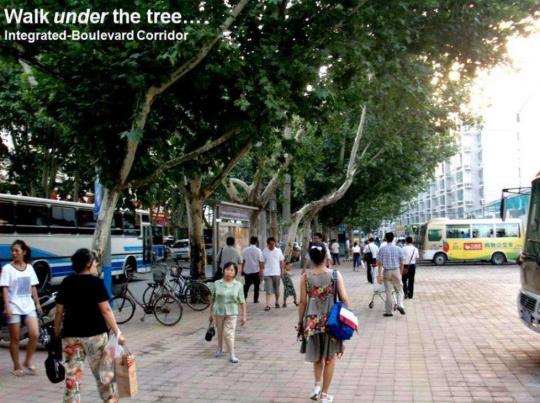As traffic congestion continues growing in urban areas, more and more cities have realized that investment priority should be given to public transport modes, such as metro trains, bus rapid transit systems (BRT) or buses, instead of personal vehicles. Simply put, public transport modes are more efficient than personal vehicles in terms of carrying and moving people around. However, international experiences also tell us that building more metro lines or putting more buses on the road alone may not be able to get more people to use public transport modes.
There are several non-transport factors, or urban design factors, that play a critical role in a traveler’s decision on their best travel mode.

The first critical factor is density. As illustrated in a famous study done by Alain Bertaud, a former World Bank staff, density is the primary reason why 30 percent of daily trips are carried out by public transport in Barcelona, but only four percent in Atlanta. Barcelona is about 30 times denser than Atlanta, so it is therefore much easier to provide same level of public transport services in Barcelona than Atlanta.
One lesser-known factor is accessibility. Just having a high population density may not guarantee more people to use public transport.

Let’s look at Beijing, London and New York. On average, Beijing has a much higher population density than London and New York in the city center (see Figure 1), but public transport mode share in Beijing is much less than that of New York and London. Why?
From our partners:
A World Bank case study, “Measuring Pedestrian Accessibility: Comparing Central Business and Commercial Districts in Beijing, London and New York”, takes a close look at the urban fabric of three cities helps us understand the reasons.
Let’s go to a metro station in each central business district of the three cities: Guomao in Beijing, Oxford Circus in London and Grand Central Station in New York.
Researchers from the World Bank found out the number of jobs located inside the areas that can be reached within a 20-minute walk from the three metro stations is quite different; Guomao has the lowest number and Union Station has the highest. Since people normally can walk for a maximum of 20 minutes without a break, those whose offices are located inside the catchment areas would be able to walk from the metro station to the office (or walk from the office to the metro station) without difficulties, and therefore the likelihood for those people to use metro for commuting is higher than those whose offices are located outside the 20-minute catchment areas.
Among three cities, the fact that Beijing has the lowest number of jobs located within convenient walking distance from the busiest metro station explains why Beijing has lower mode share by public transport than other two cities.
However, why would this have happened? Did we forget that Beijing has higher population density than New York and London? A further closer look found out that the urban spatial environment in the three cities is quite different (Figure 2):
- Very wide streets, large street blocks and buildings set-back quite far from the edge of the streets in Beijing;
- Narrow streets, very small street blocks, buildings right on the edge of the streets in New York and London.

Because of these differences in urban fabric, the number of buildings and the size of office floor areas in Beijing that are located within the 20 minutes walking distance from metro stations (or accessible by metro) actually are not big, despite the fact that Beijing has the highest density (on a city wide average) among these three cities.

Another often-overlooked factor is walkability. A World Bank-funded study, “Walk the line: station context, corridor type and bus rapid transit walk access in Jinan, China,” finds that in some places, people who live more than 900 meters away from the BRT line come to use the BRT by foot; but in some other places, many people whose houses are just more than 100 meters away from the BRTS stations do not come to use the BRT.
To figure out why, the researchers did site visits and interviews of BRTS users. Figure 3 shows a street that is not very wide, covered by trees and there are many shops along the street. Many people walk while shopping on that street each day. People interviewed there said they like to walk on that street and they don’t really feel tired, even when they walk a long distance. That is the place where people walk up to 900 meters to come to use the BRTS.
Figure 4 shows another place where there are a very wide elevated road, a narrow and poorly maintained sidewalk, and very few trees. No one interviewed there said they’d like to walk on that street. That is the place even those who live only 100 meters away from the BRTS would not come to use the BRTS.

Many developing cities are now building or planning to build metro and BRT, with an aim to get more people to use public transport instead of private vehicles. These efforts should definitely be applauded.
However, it is also important to look at those critical non-transport factors that are affecting people’s decision on the use of public transport, such as density, accessibility and walkability, as discussed above. Better urban planning and complementary investment in urban spatial environments to address issues are also very necessary.
This article is written by Dr. Ke Fang, Lead Transport Specialist at The World Bank and originally appeared in World Economic Forum.
















